
The Teatro dei Rozzi is a live-performance theater located on Piazza Indipendenza #15, in the city of Siena, region of Tuscany, Italy; while this structure was inaugurated in 1817, the sponsoring organization dated to 1531.

The Teatro dei Rozzi is a live-performance theater located on Piazza Indipendenza #15, in the city of Siena, region of Tuscany, Italy; while this structure was inaugurated in 1817, the sponsoring organization dated to 1531.
In 1531, a group of artisans created the Congregation of Rozzi dedicated to mainly oral performances of secular poetry, often during festivals. At this "academy", intellectuals and literati of the town attempted to refine the more popular forms of theater into more sophisticated art. By some it was called the Academy of the Uncouth for its avoidance of Latin texts. [1] The group took on an emblem and symbol, the cork tree which draws from the ground. It is said among those attending performances were Pope Leo X and Holy Roman Emperor Charles V. [2]
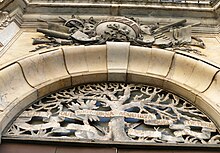
During the middle decades of the 17th century, the Rozzi specialized in readings of pastoral drama, while later in the 17th century, it was occupied with the satirical comedies by Girolamo Gigli (1660-1722) and the comedies of character by Jacopo Angelo Nelli (1673-1767), and works of Pietro Fortini. [3]
The congregation was transformed into the Academy of the Rozzi in 1690, to which Francesco de' Medici, granted use of rooms in the Palazzo Pubblico of Siena. During the 18th and 19th centuries it became a more prestigious cultural institution in town, fostering a number of dramatists, including Benvenuto Flori, Agostino Gallini, and Girolamo Ronconi.
The Accademia dei Rozzi established to build a theater in 1807, designed by Alessandro Doveri. The initial project was forsaken because it removed some of the meeting rooms of the Academy. A new locale, the present one, was obtained leading to construction of this theater in 1815 by the same architect using a different design. The Theater hall was inaugurated in 1817, with the musical play L'Agnese di Fitzenry by Ferdinando Paer.
In 1873, the architect Augusto Corbi remodeled the theater, which remained open until 1945, when damage from the Second World War caused it to close. It was later refurbished again and reopened to the public in 1998, as a theater with 499 seats, three rows of boxes and a gallery open houses and theatrical activities, music and conferences. [4] [5] The Accademia dei 'Rozzi' still maintains a library and archive of it past works and functions. [6]

The Accademia di Belle Arti di Firenze is an instructional art academy in Florence, in Tuscany, in central Italy.
Azio Corghi was an Italian composer, academic teacher and musicologist. He composed mostly operas and chamber music. His operas are often based on literature, especially in collaboration with José Saramago as librettist. His first opera, Gargantua, was premiered at the Teatro Regio in Turin in 1984, his second opera, Blimunda, was first performed at La Scala in Milan in the 1989/90 season, and his third opera, Divara – aqua e sangue, was premiered in 1993 at the Theater Münster, Germany. He taught composition at the Accademia Nazionale di Santa Cecilia in Rome, among other academies. In 2005, he was awarded the Order of Merit of the Italian Republic.
Beyond Florence, there are nine other provinces in the region of Tuscany, named for the largest city in, and capital of, the respective province. Taken together, they offer an intense musical life.
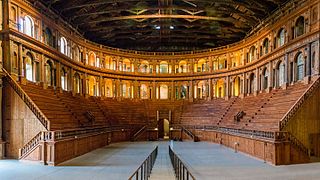
Teatro Farnese is a Renaissance theatre in the Palazzo della Pilotta, Parma, Italy. It was built in 1618 by Giovanni Battista Aleotti. The idea of creating this grand theater came from the Duke of Parma and Piacenza Ranuccio I Farnese. It was part of the complex of the Ducal Palace of Parma. The theatre was almost destroyed by an Allied air raid during World War II (1944). It was rebuilt and reopened in 1962.

The Accademia delle Arti del Disegno is an academy of artists in Florence, in Italy. It was founded on 13 January 1563 by Cosimo I de' Medici, under the influence of Giorgio Vasari. It was initially known as the Accademia e Compagnia delle Arti del Disegno and consisted of two parts: the company was a kind of guild for all working artists, while the academy was for more eminent artistic figures of the Medici court, and supervised artistic production in the Duchy of Florence.
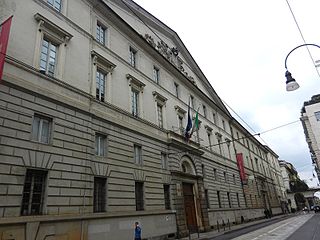
The Accademia Albertina di Belle Arti is an institution of higher education in Turin, Italy

San Pellegrino alla Sapienza o della Sapienza is a Gothic style, Roman Catholic church located at the intersection of via della Sapienza and via delle Terme in Siena, region of Tuscany, Italy. It is located across from the Teatro dei Rozzi.
Accademia often refers to:

The Teatro Alfieri was a major theatre and opera house in 18th and 19th century Florence, located at Via dell'Ulivo #6 corner Via Pietrapiana in the Florence, region of Tuscany, Italy.
The following is a timeline of the history of the city of Florence, Tuscany, Italy.

The Palazzo Palmieri, or Palazzo Nuti, is a Mannerist style urban palace, located on Via del Moro #48 in the present contrada of Civetta, Terzo di Camollia of the city of Siena, region of Tuscany, Italy.

The Teatro Goldoni of Florence was first opened in 1817 at the site of the former Annalena monastery in Oltrarno, region of Tuscany, Italy. The theater, dedicated to the playwright Carlo Goldoni, has a main facade on the narrow Via Santa Maria #15, it is near the corner with Via de Caldaie.
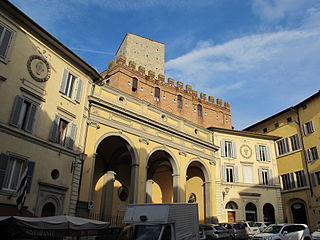
The Piazza or Piazzetta dell'Indipendenza is located just north of Piazza del Campo in the Terzo di Camollia in the city of Siena, region of Tuscany, Italy. It is located centrally at the intersection of Via delle Terme and dei Termini, about two blocks Northwest of the Piazza del Campo.
The Teatro Contavalli was an opera house and theatre located at Via Mentana #2, in Bologna, region of Emilia-Romagna, Italy. Long since utilized as a theater, the site is now occupied by offices for the Centro Italiano di Documentazione sulla Cooperazione e L' Economia Sociale.
Enzo Carli was an Italian art historian and art critic.
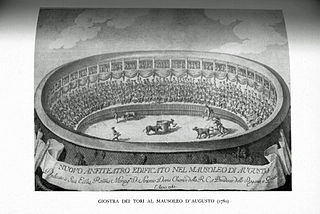
The Anfiteatro Correa was an amphitheatre in 1870 in Rome, Italy and was later known as the Anfiteatro Umberto I. In 1908, the threatre was transformed into a concert hall known as the Teatro Augusteo.
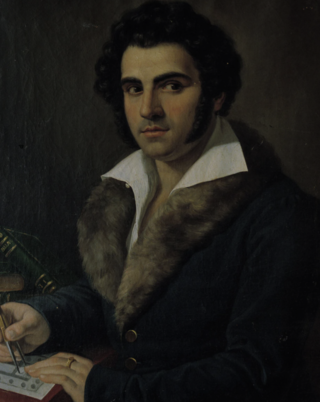
Niccolò "Nicola" Matas was an Italian architect and professor. He is best known for being the architect of the 19th century Gothic Revival façade of the Basilica of Santa Croce in Florence, Italy. Matas was a professor at the Academy of Fine Arts, Florence. He is one of the important architects in the history of the city of Florence.

The Teatro Fraschini is an opera house in Pavia, Italy.

The Teatro degli Industri is a theatre and opera house in Grosseto, Italy. It is the historic theatre of the city and one of the two municipal theatres together with the Teatro Moderno.
Augusto Corbi was an Italian architect, active mainly in his native Tuscany.